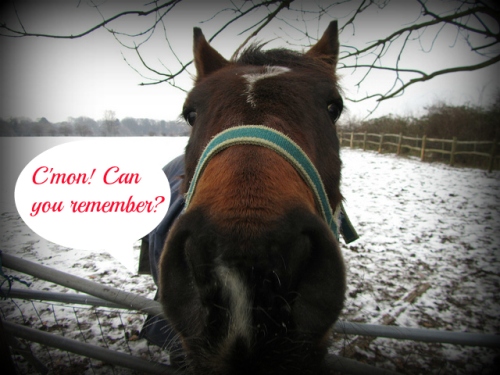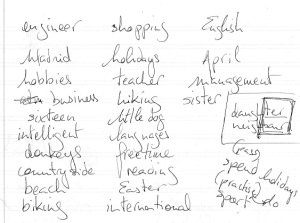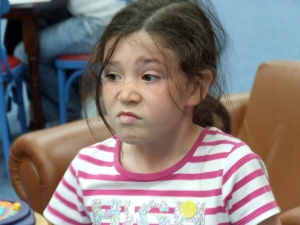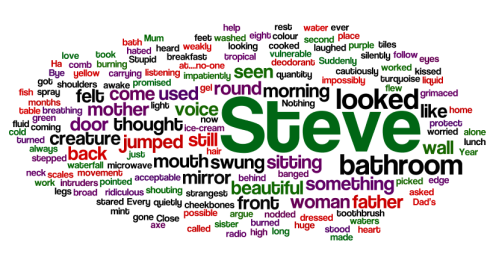It don’t mean a thing if it ain’t got that swing..
This is the fifth post in a series of six on the-chicken-and-the-egg relationship between confidence and learning, and on building your students’ confidence by supporting (ie increasing) their learning through personalizing, emotional engagement, repetition and complete body involvement. The first posts were an introduction on the importance of confidence itself, two on personalising and one on emotional response, so, hey, guess what this one is on. No prizes, sorry. If you haven’t read it, though, please have a quick dip into the first of the posts for some context before reading on.
Repetition is repetitive? You can say that again!

Better with filling. Image by Phil Bird at eltpics
Repetition undoubtedly helps learning BUT as with ‘personalisation’ as a term, my take on repetition in this post is not, perhaps, the standard. Or at least I take it to mean two distinct things, one has nothing to do with language drills, but with integrated skills, and the other is ‘drilling with filling’: what the Cornish pasty is to pastry, this type of repetition is to the language drill.
Obviously, meaningless drilling – drilling language that is of no true consequence to learners, that produces no emotional response and has no bearing on students’ lives – will not result in long-term learning (how long did you take to learn your Latin declensions?), but that’s pretty much true of any ‘indifference-inducing’ approach used in class, not just of drills. But even when the content of the drill has personal relevance, there’s more to the actual drilling than is first apparent or than may be taken into account in the classroom. How do you memorise telephone numbers? You personally. And songs (lyrics and modulation)? People’s names? Just saying them over and over and over and over and….., or is there more to it?
Have a go at these ‘tasks’:
Here’s a phone number. Read it once, memorise it, then scroll down as far as the questions below the photo of a horse, and answer the questions.
00441334467892
Now for a song. Click on the song link, and listen as far as 1:28 (or 0:55 if you’re pushed for time) twice. Then come back here and answer these questions:

Norah Jones Image from Wikipedia
Song questions
Can you write down the lyrics without checking them anywhere?
Can you now sing the verse – lyrics and tune, with all (or at least most of) its modulations?
How did you memorise the lyrics?
How did you memorise the modulations in the tune?(or the tune)
Final task – when you meet a class of new students, how do you learn their names? How efficient is your system? What percentage of the names do you still remember on the second day?
For generations of teachers (and students), repetition has meant drilling, listen and repeat and repeat and repeat and repeal and appeal and appall…… Is that truly efficient without another layer of brain activity or ‘hand activity’? How long do you repeat a phone number to yourself? Surely ‘until I find a piece of paper to write it down on’ is one of the answers to that? Can mindless, droning repetition help learning? Personally I very much doubt it. (Now you can horse-jump down to just after Now scroll back up.)

Well, can you? Image by Phil Bird at eltpics
Phone number questions:
What was the number? Write it down but don’t check it yet.
How did you recall it? Note how you did it.
Now scroll back up.
*******************************************
My answers to the tasks I set above would be as follows; how do they compare to yours?

Call me, on the line, call me…. Image by Hana Tichá at eltpics
Phone numbers – I create my own associations (see third post), such as years of my life or in history when something happened or the age I was when they happened, songs (n-n-n-n-Nineteen), sequences or other associations, and combine them. I have a friend whose old phone number was easy – James Bond’s number + ‘the number of the beast’. Sometimes it’s just the sound of a number, so, in effect, I sing it – our phone number when I was a child was 29209, and I still remember it 35 years on. What do you do?
Songs – I visualize the scene the lyrics describe, or a combination of images, mental images, a video in the mind, and any rhymes or alliteration and so on (ah, la sémiotique…) can help. As for the tune, I use my hand for the tricky bits, a flattened hand testing the air at different heights as if inserting my hand into letterboxes in a block of flats, or a finger tracing the rises and falls as my hand reinforces my voice (see the sixth post in this series – still to come).
Names – I learn 90% of my students’ names in the first 5 or 10 minutes of day one. I ask them their name, and then, out loud I drill myself (verbally!), but obviously with the students sitting in front of me, there are visual stimuli – faces, colours, glasses and facial hair, the geography of where they’re sitting, the clothes they’re wearing, who looks like who, who has the name of a monarch, a saint or other religious figure (I’m in Spain), names I like, names I don’t like…. all these clues help. It’s rather like doing an Invisible Drill (or Disappearing Drill). How about you?
Whatever your answers to the questions, I doubt that straight, repetitive drilling with no imaging or similar helped your memorising and certainly not in the long term, and this must be true in the classroom too. Methodology has moved on from dull old ‘repeat repeat repeat (change one element) repeat repeat repeat’, but it hasn’t always gone far. Look at pronunciation: listen and repeat. What good is that? In a class of 35 students, how can you tell if they’re all improving their pronunciation, who knows how efficient each one is, and just how motivating is it anyway?
No, as we know that repetition does help learning, we have to find ways to support the process, to make it meaningful (in a personalized way) and to make it motivating (indifference is learning’s worst enemy – see the fourth post in this series).

Sometimes you just need a drill Image by Hana Tichá at eltpics
Ideas
Imaging and associations – encourage them to make associations, but rather than the ‘where would you put it on an elephant?’ sort of things, ask them to create associations in their own way, then put them in groups to discuss the associations – this helps gelling, and of course forces them to repeat exposure to the language item probably more than once, saying it and hearing it.
I’ve seen Scott (Thornbury) getting teachers to do a drill whereby they only repeat the sentence if it’s true for them, or adding true information (like drilling with a gapfill). I imagine this works for smallish language chunks. Does it ‘fix’ the language beyond the short- or medium-term? I don’t know.
Drawings – I remember students telling me they wanted to learn Life by Des’ree (young teens) to sing at the school concert. Just singing it over and over would have been the death of it, especially with that age-group, so I played it and asked them to ‘catch’ words ie pick out any words they understood. We then put the words on the board (ghost, toast, dark, park, rabbit, foot, walk, beautiful balloon etc) and grouped them according to whether they were in the same bit of song or not. The students then drew A4-sized pictures and listened again to see if they could add any words to the board, and consequently any elements to the pictures. Then they read the lyrics and improved on their pictures in groups, redoing them on card, three people and three pictures per group – team-drawing, I guess. When they were happy, they stood holding their pictures and we played the song. They put themselves in order, depending on where their picture came in the song. Then they read the lyrics again, but only the bit before their drawing, the bit after and their own bit, and then we sang as a group, and each kid raised their picture as they sang. Theoretically it was a sort of round, but they actually tried to sing along to most of the song, and the chorus is – well, repetitive 😉 It was a laugh, they all got involved and learnt something and it took as long as any ‘song’ class – the tallest girl in the class (a so-called problem student) organized a dance routine (which, of course, they did again and again while singing again and again), and in the end, they performed the song at the end of year show, complete with dance in the chorus and pictures illustrating the rest. Essentially, they heard and sang the song again and again, but they also created associations (images) and added a physical aspect to it too. (I’ve noticed that students learn songs if they can dance or jiggle along, so using youtube is great, as it draws the attention of classmates to the screen and not to the student having a jiggle.)

You wanna fly around the world in a beautiful balloon. Image by Victoria Boobyer at eltpics
TPR and drama – TPR seems to work, as do drama activities. The involvement of a physical element reinforces what the mouth and mind (and ear) are doing, deeper associations are created, and the body’s memory kicks in. In the book Dictation by Paul Davis and Mario Rinvolucri (Cambridge University Press, 1989), there was a wonderful activity about ‘Stand in front of the coke machine. Put your hand in your back pocket….’, whereby TPR was used to prep the writing stage. There was no ‘listen and write’ stage – the students listened and did, then listened, did and said, then said and did, and finally wrote it down and checked with a partner. Vocabulary was learnt and whole chunk language dominated over individual items.
As for drama, I use a lot of drama techniques in class (revealing a frustrated ambition, perhaps) – and will give an example in the next post – but for now, have a look at this video a teacher trainee drew my attention to (thank you, Jelena Mihajlov 🙂 ), and consider how you could use it to drill language chunks in class. Great fun, hey? And, as my trainee, Jelena (and many others, particularly where style and elegance, or unplugged teaching are concerned – and this is, after all, an unplugged teachers’ blog ;)) said, ‘less is more’.
Integrated skills
Repetition in its most useful sense really works best through “Integrated Skills”, where students are likely to be exposed to language via the four skills, so its sound-shape, written shape, how to say it and how to write it in a context are all combined. Theoretically, this is what contemporary coursebooks do, but if the language comes from the students (’emerges’ – why do buzzwords irk me so much?), it’s more memorable. This summer, I was asked how to say bales of hay (the students had seen some), so I extended the conversation to take in Make hay while the sun shines, and from there to Strike while the iron’s hot, which, it turned out, has a direct translation in

Make hay…. Image by Ian James for eltpics
Belarusian (and Ukrainian and I think Polish). I asked my students to teach me to say it in their language, so when I said it in Belarusian, they had to tell others what I was trying to say! We wrote down the two phrases, so there was reading and writing as well as listening and speaking, and they got to laugh at my attempts.
I’ll be writing on Integrated Skills another time, and it’ll be central to the next post, so I’ll leave it for now… but the link to repetition is obvious.
Other drilly ideas
Choose phrases or words from the previous class, or from the week before to be ‘Phrases/words of the day’, and award points to students who manage to incorporate them into the class, either in questions or in debate or….whenever they can. Mix easier with harder ones like, say, Make hay while the sun shines. This can cause amusement and works rather like the Whoopi Goldberg video above.
When getting students to drill pronunciation, I think there are a certain number of activities that produce spontaneous self-drilling (like when you go to the supermarket and scan shelves “lentils, lentils, let me see, where the heck are the lentils….. aha, lentils – oh, reduced salt, oh well, they’re lentils. Now, where’s the basil…basil……..hmmm”). Pelmanism (the memory game involving turning cards over to make pairs) is an old chestnut, as it works rather like the hunt for lentils, but here’s another (which is good for learning students’ names on the second or third day, if you still can’t remember them):
Divide the class into three or four groups, depending on the size of the class. Ask them to try to remember and take notes on everything they’ve learnt so far about the others in the class ie NOT the people in their group – they are going to tell you everything they know about each other. As they speak, move around with a small notebook, noting down words you hear related to students in the room but that contain the particular sound, minimal pair etc. that you want to work on. In my context (Spain), I usually focus on the /iː/ and /ɪ/ sounds – here’s a page from my notebook from last month.

Learner-generated language for work on the long and short ‘i’ sounds.
When they’ve finished, groups tell me what they know (and usually have a laugh when they get things wrong – “Mar wants to study Business Admin – right, Mar?” “Um, I want to study Civil Engineering…” “Oh, sorry. And she’s got two cats.” “I have a dog and a boyfriend.” etc.) and while I’m listening, I note more words or phrases down. This first stage really helps gel the new class as a group and is a nice, safe, early speaking task where language isn’t too challenging, it’s probably reviewing items they did in the last class, so they can focus on the actual speaking to each other. I feed in vocab as they need while I monitor, and listen and note. After the groups have all reported back, I write the language on the board and point out that each word or phrase contains an /iː/, an /ɪ/ or both; I usually underline the syllables where the sounds occur. We do some work on how to pronounce each sound, where it’s produced, what the lips do (especially the corners of the mouth in this case) when you say them (smile, no smile – teaching is a smiley profession, whereas working as a civil servant isn’t etc.). Students then work with a partner to say the words and decide if it’s the long or short sound, and we feedback. THEN, and this is where the repetition comes in, the self-drilling meaningfully, pairs or fours have to decide which student is referred to by each word: “Who was the engineer?” “I think Javi’s an engineer…” “No, Javi’s a P.E. teacher, Carmen’s an engineer. So’s Ruth.” “Ah yes. OK, that’s two engineers” and so on. (NB my summer classes had a mix of ages from 15 to 50+ – this works with any age).
You can do this kind of thing with complete sentences at the end of a class or week, ‘Who said the following things?’ after correcting, say, the present perfect or whatever language point you want to do – vocab., pron and grammar all lend themselves to it. It involves talking about each other, instead of about themselves (which can be touchy, Twilight Zone stuff), helps glue the group, provides repetition of language, is communicative, allows for associations to be made and a slew of and so on and so forths.
So. A few ideas from me. What about from you?






































